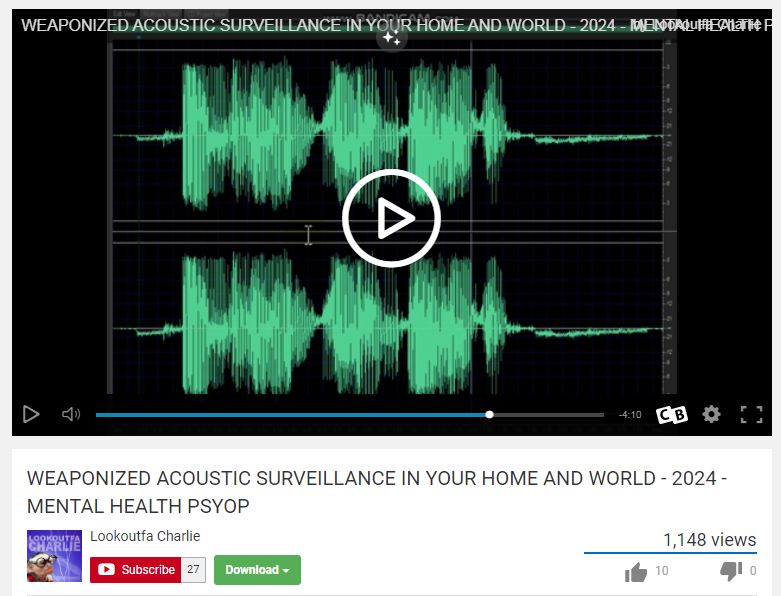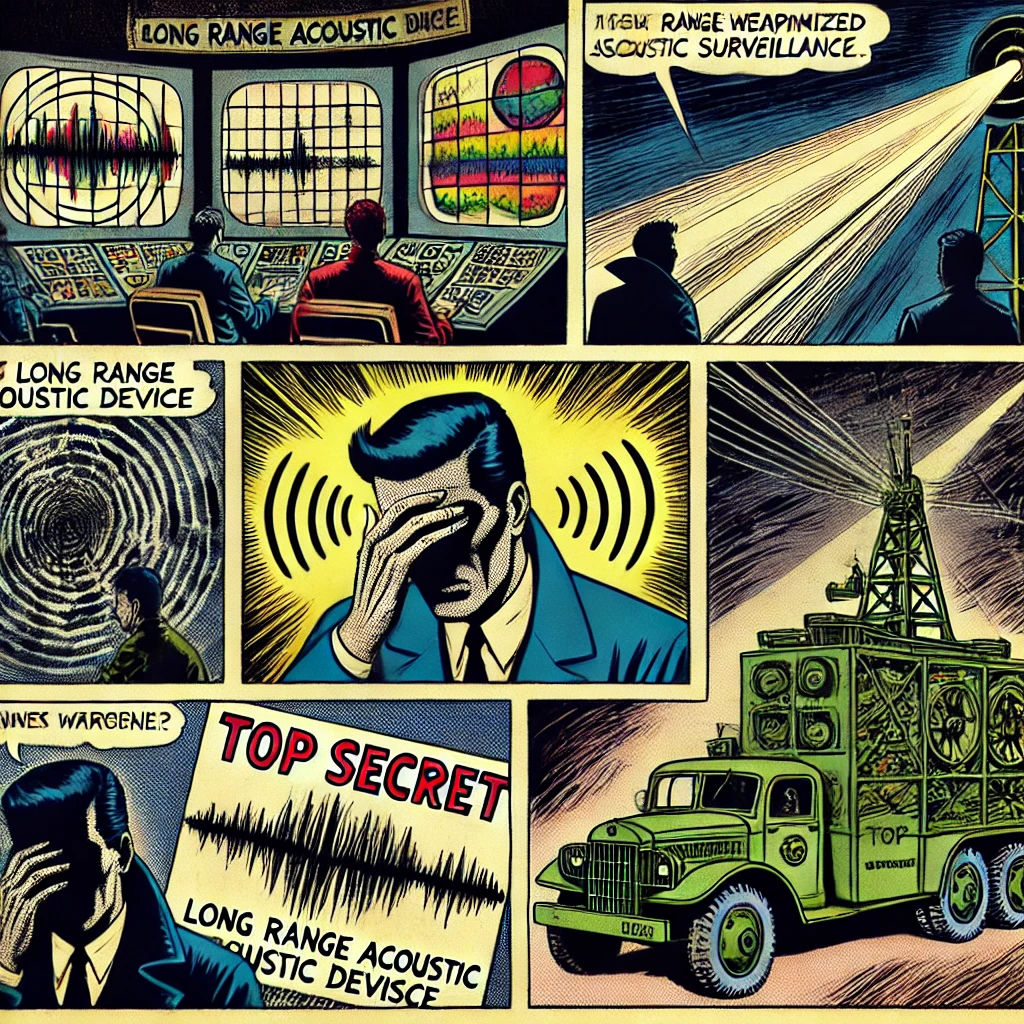Hearing Voices Weaponized Acoustic Surveillance and Suggestion Remote Neural Monitoring 2024
Voice to Skull patented technology. REMOTE NEURAL MONITORING federal court case.
https://153news.net/watch_video.php?v=249YA6UOYKY2
Hearing Voices
The concept of “hearing voices” in the context of weaponized acoustic surveillance, suggestion, or remote neural monitoring touches on a range of speculative, controversial, and highly sensitive topics that blend elements of science, conspiracy theories, and emerging technologies. It’s important to approach these subjects with a critical eye and distinguish between scientifically validated phenomena and speculative or unsupported claims.

Acoustic Technologies and Voice Transmission
Advancements in acoustic technology have led to the development of devices capable of transmitting sound over long distances in a highly directional beam. One well-known application of this technology is the Long Range Acoustic Device (LRAD), used by law enforcement and military organizations for crowd control and communication over distance. However, the LRAD and similar devices are designed for loud, clear communication or deterrent sounds, not for covert operations or inducing psychological effects.
The “Voice to Skull” (V2K) Phenomenon
The term “Voice to Skull” (V2K) refers to a supposed technology that can transmit voices or sounds directly into a person’s head without the need for any receiving device. While this concept has been a topic of speculation and is often cited in conspiracy theories, there is no publicly available scientific evidence to support the existence of such technology for the purposes described in these theories.
Remote Neural Monitoring
Remote neural monitoring is another concept that has been the subject of speculation and conspiracy theories, suggesting the possibility of remotely observing or influencing a person’s thoughts or brain activity. While neuroscience and neurotechnology have made significant strides in understanding and interfacing with the brain, the idea of remotely monitoring or controlling thoughts without direct physical intervention (such as implants or electrodes) remains firmly in the realm of science fiction based on current publicly known science and technology.
Ethical and Privacy Concerns
The topics of acoustic surveillance, remote influence, and neural monitoring raise significant ethical and privacy concerns. The prospect of technologies that could intrude on an individual’s private mental space or manipulate their perceptions without consent is troubling. These concerns underscore the importance of ethical guidelines and regulatory oversight in the development and application of advanced technologies.
Conclusion
While technology continues to advance in areas related to sound transmission and neuroscience, the concepts of weaponized acoustic surveillance, “hearing voices” through undisclosed means, and remote neural monitoring as often depicted in speculative discussions lack substantiation from the scientific and technological communities. It’s crucial to rely on verified information and remain aware of the distinction between emerging technological capabilities and speculative or fictional portrayals.
Voice 2 Skull Tech – V2K
The concept of “Voice to Skull” (V2K) technology often references a real patent that fuels much of the discussion around this topic. The patent in question is often cited as U.S. Patent 4,877,027, granted to Dr. Oliver M. Lowery in 1989, titled “Method and Device for Implementing the Radio Frequency Hearing Effect.” This patent describes a technology that can transmit sounds and speech directly into a person’s head through pulsed microwave frequencies, without the need for any receiving device implanted in the person’s ear.
Key Aspects of the Patent
– Technology Basis: The patent is based on the discovery of the “microwave hearing effect” by Allan H. Frey in the 1960s, where microwaves were found to produce audible clicks or even understandable speech when modulated with certain frequencies and aimed at the head.
– Non-Auditory: The technology described in the patent bypasses the ears and conventional auditory mechanisms, directly stimulating the brain’s auditory cortex.
– Applications: The patent suggests potential applications for this technology, including direct communication with hearing-impaired individuals, covert operations, and crowd control, among others.
Controversy and Speculation
The existence of this patent has led to a variety of speculative claims and conspiracy theories. Some individuals believe that such technology has been further developed and deployed for purposes of surveillance, mind control, or harassment, often citing personal experiences of hearing voices that they attribute to V2K technology.
Scientific and Ethical Considerations
– Public Evidence: There is limited public evidence that the technology described in the patent has been developed to the extent claimed by some theories. Most research into related areas, such as brain-computer interfaces and neurotechnology, is conducted under strict ethical guidelines due to the invasive nature and potential for abuse.
– Technological Limitations: While the microwave hearing effect is a documented phenomenon, translating it into a practical, controllable technology for the transmission of complex messages at safe power levels poses significant technical challenges.
– Ethical Concerns: The ethical implications of any technology capable of transmitting voices directly into the human brain are profound. Such capabilities would raise serious questions about privacy, consent, and mental autonomy.
Conclusion
The “Voice to Skull” (V2K) patent represents a fascinating intersection of technology and perception, contributing to ongoing discussions about the limits of communication technology and the potential for direct brain stimulation. However, the speculative uses of such technology, particularly those involving non-consensual application, remain unsupported by credible scientific evidence and are viewed critically by both the scientific community and ethical standards governing research and technology development.

Son of Sam claimed to have heard voices from a dog. Mark David Chapman, supposed shooter of John Lennon, claimed to have heard voices in his head, screaming “Shoot! Shoot!”. Gail Sloatman, wife of Frank Zappa, claimed to have heard voices in her head along with many, many others. We’ve known of the ‘my tooth-filling demodulates an AM radio signal that I can hear inside my head/mouth’. The on-purpose technology: Voice-to-Skull (“V2K”) technology, using modulated microwave carrier waves, is not only real but patented…
Is it conceivable that there exist “evil waves”, evil not just in their end message of evil intent, but also ‘indirectly evil’ by way of the waveforms also being corruptive due the nature of the message and end intent that they carry? Could this be another reason behind the age-old fearfulness of innuendo, rumors, slander? Does the Way you Say the words that you say Also Matter?
Could this explain why “news” is constantly skewed to the negative? The direct impact of the negative message itself (to those who hear it), but also the very boardly corruptive force of the carrying of the negative message (those exposee’s exposed to the ‘radio waves’ that carry the negative message, even if the exposee’s are never direct recipients of the negative message content itself)…